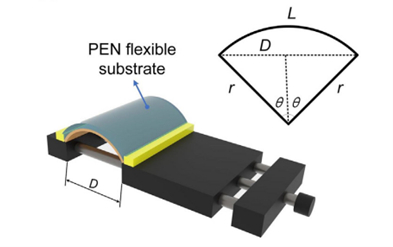Tuesday, 14 January 2025
Could Flexoelectricity be a Key to Improving the Efficiency of Solar Technology?
A recent collaboration between ICN2 and Nanchang University has discovered that the efficiency of perovskite solar cells can be enhanced by bending them. These findings could be valuable in the development of new renewable energy technologies.

Flexoelectricity is a property of certain materials that allows them to generate an electrical charge when subjected to bending or deformation. Flexoelectricity has proven to be relevant to very diverse fields, including engineering (energy harvesting), telecommunications (frequency filters), and even biomedicine (bone fracture healing). A coupling between flexoelectricity and photovoltage, known as flexophotovoltaic effect, was also discovered recently, but it was not known to what extent this coupling was relevant for the performance of actual solar cells used for photovoltaic energy generation.
A collaboration between ICREA Prof. Gustau Catalán, head of the ICN2 Oxide Nanophysics Group, and Prof. Longlong Shu from Nanchang University has addressed the question of whether the flexophotovoltaic effect can be used to improve the performance of solar cells. This research was recently published online in the journal Matter.
Specifically, this study analysed flexible halide perovskite solar cells, such perovskites being a type of material intensively investigated in solar energy generation due to their excellent photovoltaic efficiency. The results showed that, indeed, when a solar cell was subjected to different types of non-uniform strain (e.g. bending or indentation), its photovoltaic efficiency (in other words, the amount of electrical energy generated divided by the amount of solar energy received) could be very significantly increased or decreased depending on the direction of the deformation.
Their findings highlight the importance of flexoelectricity in optimising current solar cells, not only as a means of improving their efficiency but also as a threat to their performance if the magnitude and orientation of the strain gradient are not considered in the design. More broadly, the results also demonstrate new possibilities for developing flexible solar technologies, which could have a wide range of applications, including manufacturing portable devices and architecture.
Reference article:
Wang, Z; Zhong, H; Liu, Z; Hu, X; Shu, L; Catalan, G. Strain-gradient-induced modulation of photovoltaic efficiency. Matter (2024). DOI: https://doi.org/10.1016/j.matt.2024.11.024. (Available in access until February 5th).

